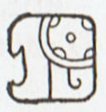|
There is a central
sign in Pax which returns in Vayeb:
 |
 |
 |
 |
|
16 Pax |
17 Kayab |
18 Cumhu |
19
Vayeb |
|
301-320 |
321-340 |
341-360 |
361-365 |
The sign (tun)
has been compared with a wooden drum:

"The tun glyph
was identified as a wooden drum by Brinton (1895, p. 92), and
Marshal H. Saville immediately accepted it. Figure 49 [excerpt
above] shows the Aztec drum representation relied on by Brinton to
demonstrate his point. It was not then known that an ancestral Mayan
word for drum was *tun: Yucatec tunkul 'divine drum'
(?); Quiche tun 'hollow log drum'; Chorti tun 'hollow
log drum' (Wisdom 1940, pp. 175-176)." (Kelley)
A drum was anciently
the means by which to communicate with the gods above, the shaman's
instrument. At the end of years drums are useful.
We can restructure
the Mayan month calendar to make it more comparable with the
calendar of the year in G:
First we should
notice the open top in 5 Tzek, the first of 10 sun months, which
surely must mean that sun is arriving, because also 16 Pax has this
type of open top (to let the sun escape):
 |
 |
|
5
Tzek |
16
Pax |
The sign at top
left in Tzek is reversed compared with the similar sign in
Pax. The Mayan glyphs have the future at left and the past at
right. It means that in Tzek the future sign points upwards, while
in Pax it points downwards.
There
are 4 months of spring and then comes the rain. 4 * 20 = 80 days for
spring can be compared with 4 months counted by a measure between
28.5 to 31 (i.e. equal to 114 - 124 days) according to the G
calendar:
"The
[tun] glyph is nearly the same as that for the month Pax
(T549), except that the top part of the latter is split or divided
by two curving lines. Brinton, without referring to the Pax
glyph, identified the tun glyph as the drum called in Yucatec
pax che (pax 'musical instrument'; che < *te
'wooden). Yucatec pax means 'broken, disappeared', and Quiche
paxih means, among other things, 'split, divide, break,
separate'. It would seem that the dividing lines on the Pax
glyph may have been used as a semantic/phonetic determinative
indicating that the drum should be read pax, not tun
(cf. de Gruyter 1946, p. 27). Thus, one may expect that this glyph
was used elsewhere meaning 'to break' and possibly for 'medicine'
(Yuc. pax, Tzel., Tzo. pox)."
(Kelley) |



























